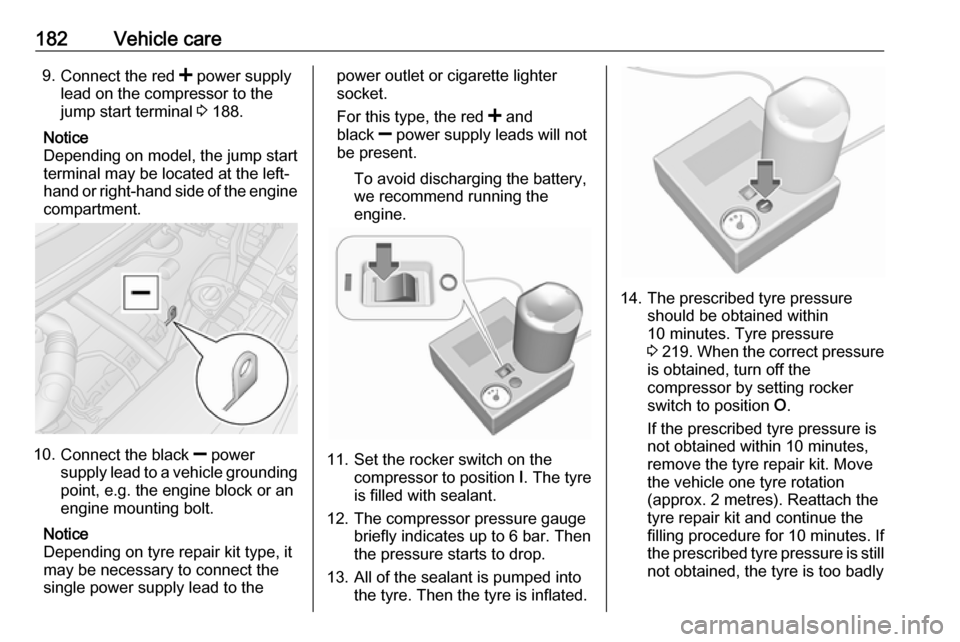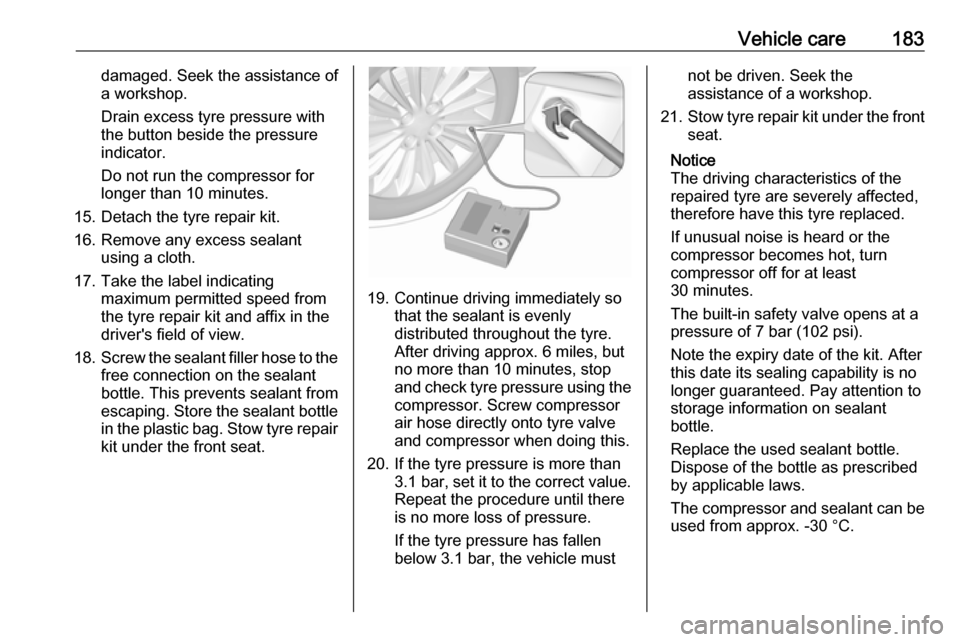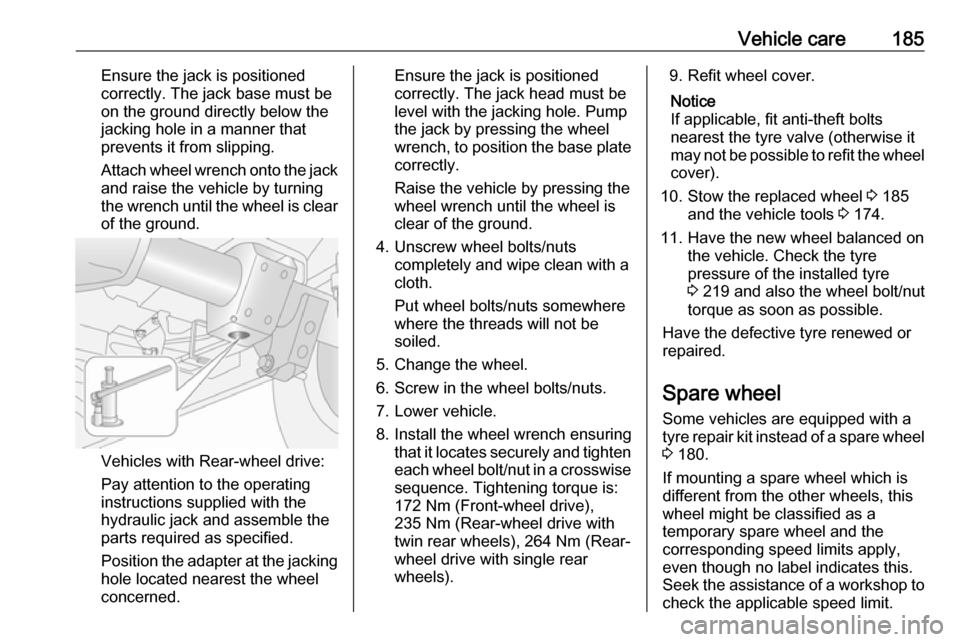2016 VAUXHALL MOVANO_B tyre pressure
[x] Cancel search: tyre pressurePage 184 of 233

182Vehicle care9.Connect the red < power supply
lead on the compressor to the
jump start terminal 3 188.
Notice
Depending on model, the jump start
terminal may be located at the left-
hand or right-hand side of the engine compartment.
10. Connect the black ] power
supply lead to a vehicle grounding
point, e.g. the engine block or an
engine mounting bolt.
Notice
Depending on tyre repair kit type, it
may be necessary to connect the
single power supply lead to the
power outlet or cigarette lighter
socket.
For this type, the red < and
black ] power supply leads will not
be present.
To avoid discharging the battery,
we recommend running the
engine.
11. Set the rocker switch on the compressor to position I. The tyre
is filled with sealant.
12. The compressor pressure gauge briefly indicates up to 6 bar. Then
the pressure starts to drop.
13. All of the sealant is pumped into the tyre. Then the tyre is inflated.
14. The prescribed tyre pressureshould be obtained within
10 minutes. Tyre pressure
3 219 . When the correct pressure
is obtained, turn off the
compressor by setting rocker
switch to position O.
If the prescribed tyre pressure is
not obtained within 10 minutes,
remove the tyre repair kit. Move
the vehicle one tyre rotation
(approx. 2 metres). Reattach the
tyre repair kit and continue the
filling procedure for 10 minutes. If
the prescribed tyre pressure is still not obtained, the tyre is too badly
Page 185 of 233

Vehicle care183damaged. Seek the assistance of
a workshop.
Drain excess tyre pressure with
the button beside the pressure
indicator.
Do not run the compressor for
longer than 10 minutes.
15. Detach the tyre repair kit.
16. Remove any excess sealant using a cloth.
17. Take the label indicating maximum permitted speed from
the tyre repair kit and affix in the driver's field of view.
18. Screw the sealant filler hose to the
free connection on the sealant
bottle. This prevents sealant from
escaping. Store the sealant bottle in the plastic bag. Stow tyre repair
kit under the front seat.
19. Continue driving immediately so that the sealant is evenly
distributed throughout the tyre.
After driving approx. 6 miles, but
no more than 10 minutes, stop
and check tyre pressure using the compressor. Screw compressorair hose directly onto tyre valve
and compressor when doing this.
20. If the tyre pressure is more than 3.1 bar , set it to the correct value.
Repeat the procedure until there
is no more loss of pressure.
If the tyre pressure has fallen
below 3.1 bar, the vehicle must
not be driven. Seek the
assistance of a workshop.
21. Stow tyre repair kit under the front
seat.
Notice
The driving characteristics of the
repaired tyre are severely affected, therefore have this tyre replaced.
If unusual noise is heard or the
compressor becomes hot, turn
compressor off for at least
30 minutes.
The built-in safety valve opens at a
pressure of 7 bar (102 psi).
Note the expiry date of the kit. After
this date its sealing capability is no
longer guaranteed. Pay attention to
storage information on sealant
bottle.
Replace the used sealant bottle. Dispose of the bottle as prescribed
by applicable laws.
The compressor and sealant can be used from approx. -30 °C.
Page 187 of 233

Vehicle care185Ensure the jack is positioned
correctly. The jack base must be
on the ground directly below the
jacking hole in a manner that
prevents it from slipping.
Attach wheel wrench onto the jack and raise the vehicle by turning
the wrench until the wheel is clear
of the ground.
Vehicles with Rear-wheel drive:
Pay attention to the operating
instructions supplied with the
hydraulic jack and assemble the
parts required as specified.
Position the adapter at the jacking
hole located nearest the wheel
concerned.
Ensure the jack is positioned
correctly. The jack head must be
level with the jacking hole. Pump
the jack by pressing the wheel
wrench, to position the base plate
correctly.
Raise the vehicle by pressing the wheel wrench until the wheel is
clear of the ground.
4. Unscrew wheel bolts/nuts completely and wipe clean with a
cloth.
Put wheel bolts/nuts somewhere
where the threads will not be
soiled.
5. Change the wheel.
6. Screw in the wheel bolts/nuts.
7. Lower vehicle.
8. Install the wheel wrench ensuring that it locates securely and tighten
each wheel bolt/nut in a crosswise sequence. Tightening torque is:
172 Nm (Front-wheel drive),
235 Nm (Rear-wheel drive with
twin rear wheels), 264 Nm (Rear- wheel drive with single rear
wheels).9. Refit wheel cover.
Notice
If applicable, fit anti-theft bolts
nearest the tyre valve (otherwise it
may not be possible to refit the wheel cover).
10. Stow the replaced wheel 3 185
and the vehicle tools 3 174.
11. Have the new wheel balanced on the vehicle. Check the tyre
pressure of the installed tyre
3 219 and also the wheel bolt/nut
torque as soon as possible.
Have the defective tyre renewed or
repaired.
Spare wheel Some vehicles are equipped with atyre repair kit instead of a spare wheel
3 180.
If mounting a spare wheel which is different from the other wheels, this
wheel might be classified as a
temporary spare wheel and the
corresponding speed limits apply,
even though no label indicates this.
Seek the assistance of a workshop to
check the applicable speed limit.
Page 195 of 233

Vehicle care193Unpainted plastic body parts must not
be treated with wax or polishing
agents.
Matt filmed body parts or decor tapes must not be polished, to avoid
gleaming. Do not use hot wax
programmes in automatic car washes if the vehicle is equipped with these
parts.
Matt painted decor parts, e.g. mirror
housing cover, must not be polished. Otherwise these parts would become
agleam or the colour would be
dissolved.
Windows and windscreen wiper
blades
Use a soft lint-free cloth or chamois
leather together with window cleaner and insect remover.
When cleaning the rear window from
inside, always wipe in parallel to the
heating element to prevent damage.
For mechanical removal of ice, use a
sharp-edged ice scraper. Press the
scraper firmly against the glass so
that no dirt can get under it and
scratch the glass.Remove dirt residues from smearing wiper blades by using a soft cloth and window cleaner. Also make sure to
remove any residues such as wax,
insect residues and similar from the
window.
Wheels and tyres
Do not use high-pressure jet
cleaners.
Clean rims with a pH-neutral wheel
cleaner.
Rims are painted and can be treated
with the same agents as the body.
Paintwork damageRectify minor paintwork damage with
a touch-up pen before rust forms.
Have more extensive damage or rust
areas repaired by a workshop.
Underbody Some areas of the vehicle underbody
have a PVC undercoating while other
critical areas have a durable
protective wax coating.After the underbody is washed, check the underbody and have it waxed if
necessary.
Bitumen/rubber materials could
damage the PVC coating. Have
underbody work carried out by a
workshop.
Before and after winter, wash the
underbody and have the protective
wax coating checked.
Towing equipment
Do not clean the coupling ball bar with
a steam-jet or high-pressure jet
cleaner.
Interior care Interior and upholstery
Only clean the vehicle interior,
including the instrument panel fascia
and panelling, with a dry cloth or
interior cleaner.
Clean leather upholstery with clear
water and a soft cloth. In case of
heavy soiling, use leather care.
Page 200 of 233

198Technical dataTechnical dataVehicle identification..................198
Vehicle Identification Number ..198
Identification plate ...................199
Engine identification ................199
Vehicle data ............................... 200
Recommended fluids and lubricants ................................ 200
Engine data ............................. 201
Vehicle weight ......................... 202
Vehicle dimensions .................209
Capacities ................................ 218
Tyre pressures ........................ 219Vehicle identification
Vehicle IdentificationNumber
The Vehicle Identification Number
(VIN) is visible through the
windscreen.
The VIN is also displayed behind a
removable plastic cover on the front
right hand door step.Unclip the
covers using a flat blade screwdriver
to access.
Page 221 of 233
![VAUXHALL MOVANO_B 2016 Owners Manual Technical data219Tyre pressuresFront-wheel driveTyre pressure with full load11)EngineGross Vehicle WeightTyreFront
[kPa/bar] (psi)Rear
[kPa/bar] (psi)M9T2800215/65 R16 C340/3.4 (49)360/3.6 (52)3300215 VAUXHALL MOVANO_B 2016 Owners Manual Technical data219Tyre pressuresFront-wheel driveTyre pressure with full load11)EngineGross Vehicle WeightTyreFront
[kPa/bar] (psi)Rear
[kPa/bar] (psi)M9T2800215/65 R16 C340/3.4 (49)360/3.6 (52)3300215](/manual-img/38/19557/w960_19557-220.png)
Technical data219Tyre pressuresFront-wheel driveTyre pressure with full load11)EngineGross Vehicle WeightTyreFront
[kPa/bar] (psi)Rear
[kPa/bar] (psi)M9T2800215/65 R16 C340/3.4 (49)360/3.6 (52)3300215/65 R16 C360/3.6 (52)430/4.3 (62)3500225/65 R16 C380/3.8 (55)460/4.6 (68)3900225/65 R16 C380/3.8 (55)460/4.6 (68)11) The spare wheel should be set to the highest applicable pressure shown in the table.Rear-wheel drive, with single rear wheelsTyre pressure with full load 11)EngineGross Vehicle WeightTyreFront
[kPa/bar] (psi)Rear
[kPa/bar] (psi)M9T3500235/65 R16 C360/3.6 (52)450/4.5 (65)11) The spare wheel should be set to the highest applicable pressure shown in the table.
Page 222 of 233
![VAUXHALL MOVANO_B 2016 Owners Manual 220Technical dataRear-wheel drive, with twin rear wheelsTyre pressure with full load11)EngineGross Vehicle WeightTyreFront
[kPa/bar] (psi)Rear
[kPa/bar] (psi)M9T3500195/75 R16 C420/4.2 (61)420/4.2 (61 VAUXHALL MOVANO_B 2016 Owners Manual 220Technical dataRear-wheel drive, with twin rear wheelsTyre pressure with full load11)EngineGross Vehicle WeightTyreFront
[kPa/bar] (psi)Rear
[kPa/bar] (psi)M9T3500195/75 R16 C420/4.2 (61)420/4.2 (61](/manual-img/38/19557/w960_19557-221.png)
220Technical dataRear-wheel drive, with twin rear wheelsTyre pressure with full load11)EngineGross Vehicle WeightTyreFront
[kPa/bar] (psi)Rear
[kPa/bar] (psi)M9T3500195/75 R16 C420/4.2 (61)420/4.2 (61)4500195/75 R16 C420/4.2 (61)420/4.2 (61)11) The spare wheel should be set to the highest applicable pressure shown in the table.
The tyre pressure information label on the driver's door frame indicates the original equipment tyres and the correspondent
tyre pressures. Always inflate tyres to the pressures shown on the label.
Tyre pressure information label 3 176.
Page 224 of 233

222Customer information● Vehicle reactions in particulardriving situations (e.g. inflation of
an airbag, activation of the
stability regulation system).
● Environmental conditions (e.g. temperature).
These data are exclusively technical and help identifying and correcting
errors as well as optimizing vehicle
functions.
Motion profiles indicating travelled
routes cannot be created with these
data.
If services are used (e.g. repair
works, service processes, warranty cases, quality assurance),
employees of the service network
(manufacturer included) are able to
read out this technical information
from the event and error data storage
modules applying special diagnostic
devices. If required, you will receive
further information at these
workshops. After an error has been
corrected, the data are deleted from
the error storage module or they are
constantly overwritten.When using the vehicle, situations
may occur in which these technical
data related to other information
(accident report, damages on the
vehicle, witness statements etc.) may be associated with a specific person -possibly, with the assistance of an
expert.
Additional functions contractually
agreed upon with the client (e.g.
vehicle location in emergency cases)
allow the transmission of particular
vehicle data from the vehicle.
Radio Frequency
Identification (RFID)
RFID technology is used in some
vehicles for functions such as tyre
pressure monitoring and ignition
system security. It is also used in
connection with conveniences such
as radio remote controls for door
locking/unlocking and starting, and in-
vehicle transmitters for garage door
openers. RFID technology in
Vauxhall vehicles does not use or
record personal information or link
with any other Vauxhall system
containing personal information.